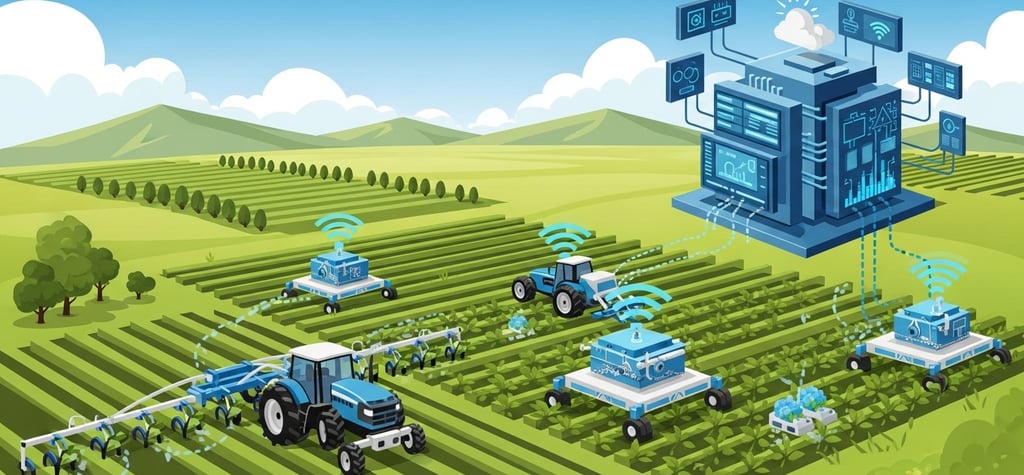From Fields to Algorithms: How Artificial Intelligence is Revolutionizing Modern Agriculture
The digital transformation of farming is reshaping how we grow food, manage resources, and feed the world's growing population I'll be honest – when I first heard about AI being used in farming, I was skeptical. Like many people, I imagined agriculture as this timeless, traditional practice that shouldn't be messed with. But after diving deep into this topic and speaking with farmers who are actually using these technologies, I've completely changed my mind. We're living through what might be the biggest agricultural revolution since the invention of the plow, and it's happening right in our backyard.
ARTIFICIAL INTELLIGENCEINNOVATIONAGRICULTURETECHNOLOGY
Hitanshu Soni
7/10/20256 min read


The Reality of Modern Farming
Let me paint you a picture of what farming looks like today. It's not your grandfather's operation anymore. I recently visited a corn farm, where the farmer showed me his smartphone app that tells him exactly which parts of his 500-acre field need more nitrogen. His tractor drives itself using GPS coordinates more accurate than what's in your car, and drones fly over his crops taking thousands of photos that get analyzed by algorithms I couldn't even pronounce.
It sounds like science fiction, but it's happening right now. And here's the kicker – it's working incredibly well.
The reason this matters isn't just because it's cool technology (though it definitely is). We're facing a real crisis. The world's population is expected to hit 10 billion people by 2050. That means we need to grow about 70% more food than we do today. And we need to do it while dealing with climate change, shrinking farmland, and depleting water resources.
No pressure, right?
Getting Personal with Plants
One of the most fascinating things I've learned is how AI is making farming incredibly personal – down to individual plants. I spoke with a tomato farmer in California who can now treat each plant differently based on its specific needs. Some plants get more water, others get different nutrients, and some might need pest treatment while their neighbors don't.
This precision farming approach reminds me of personalized medicine. Just like doctors are learning to tailor treatments to individual patients, farmers can now customize care for different areas of their fields, sometimes down to square-meter sections.
The technology behind this is pretty mind-blowing. Sensors buried in the soil measure moisture, temperature, and nutrient levels continuously. Satellites and drones capture multispectral images that reveal plant health invisible to the human eye. Machine learning algorithms crunch all this data and spit out recommendations that would take a human weeks to calculate.
But here's what really impressed me: farmers aren't just blindly following what the computers tell them. They're using AI as a super-powered assistant that helps them make better decisions based on decades of experience.
When Machines Predict the Future
I've always been amazed by how farmers seem to have an sixth sense about weather and crop conditions. Well, now AI is amplifying that intuition with predictive analytics that border on magical.
Take pest control, for example. Instead of spraying pesticides on a schedule or waiting until you can see damage, AI systems can predict when and where pest outbreaks are likely to occur. They analyze weather patterns, historical data, and current field conditions to give farmers a heads-up days or even weeks in advance.
One farmer I talked to in Nebraska told me his AI system warned him about a potential fungal infection three days before any visible symptoms appeared. He was able to apply a targeted treatment that saved his entire soybean crop. Without that early warning, he estimated he would have lost about 40% of his yield.
Weather prediction has gotten scary accurate too. While we're still checking our phones to see if it'll rain this afternoon, farmers are getting hyperlocal forecasts that tell them the exact probability of precipitation in different parts of their fields over the next two weeks.
The Robot Farmers Are Coming
Okay, so maybe "robot farmers" sounds a bit dramatic, but we're definitely headed in that direction. The autonomous equipment I've seen in action is genuinely impressive.
Picture this: it's 2 AM, and while you're sleeping, a self-driving tractor is methodically working through a field, planting seeds at precisely the right depth and spacing. It doesn't need breaks, doesn't get tired, and definitely doesn't complain about working the night shift.
But it's not just about replacing human labor. These machines are doing things humans simply can't do consistently. They can maintain perfect spacing between seeds, apply fertilizer with millimeter precision, and work in conditions that would be dangerous for people.
The really cool stuff is happening with smaller robots too. I saw a demonstration of strawberry-picking robots that use computer vision to identify ripe berries and harvest them more gently than human hands. There are weeding robots that can distinguish between crops and weeds at the individual plant level, eliminating the need for herbicides in many cases.
The Green Revolution Gets Smarter
Here's where AI is really shining: making agriculture more sustainable. And this isn't just feel-good environmentalism – it's smart business.
Water management is probably the best example. Traditional irrigation systems water entire fields uniformly, but AI-powered systems can vary watering down to individual plants based on their specific needs. I visited a vineyard in California that reduced its water usage by 35% while actually improving grape quality using these smart irrigation systems.
The environmental impact goes beyond just water savings. Precision application of fertilizers means less runoff into waterways. Targeted pest control reduces the amount of chemicals needed. Some farms are even using AI to optimize their carbon footprint, implementing practices that actually help pull carbon dioxide out of the atmosphere.
From Farm to Fork
What really opened my eyes was learning how AI is transforming the entire food supply chain, not just what happens on the farm.
Imagine if grocery stores could predict exactly what you're going to buy next week and make sure farmers grow just the right amount. That's essentially what's happening with AI-powered demand forecasting. It's reducing food waste, helping farmers plan better, and keeping prices more stable.
I was particularly fascinated by blockchain technology being combined with AI to create complete traceability. You can now scan a QR code on an apple and see exactly which tree it came from, when it was picked, how it was transported, and even the weather conditions during its growing season. It's like having a biography for every piece of produce.
The Human Element
Now, I don't want to paint this as some utopian picture where technology solves everything. There are real challenges and concerns that need to be addressed.
The biggest issue I've encountered is the digital divide. Not every farmer has access to high-speed internet or the technical knowledge to implement these systems. There's a real risk that AI could make the gap between large commercial operations and small family farms even wider.
I've also heard concerns about data privacy. When your farming operation becomes this connected and data-dependent, who owns that information? What happens if the company providing your AI services goes out of business or decides to change their terms?
Then there's the cost factor. While prices are coming down, the initial investment in AI technology can be substantial. It's not just the hardware and software – farmers often need to upgrade their entire infrastructure and get training on new systems.
What's Next?
The future possibilities are both exciting and a little overwhelming. We're talking about crops that are genetically optimized by AI to be more nutritious and resilient. Vertical farms in cities that produce fresh vegetables year-round using a fraction of the water and land of traditional farming. Supply chains so efficient that food waste becomes nearly nonexistent.
But perhaps the most promising development is how AI is democratizing access to advanced farming knowledge. Small-scale farmers in developing countries can now access the same predictive analytics and precision agriculture tools that were once only available to large agribusiness.
I recently read about a project in Kenya where farmers use simple smartphone apps powered by AI to get personalized advice on everything from planting schedules to pest identification. It's leveling the playing field in ways that could transform global food security.
The Bottom Line
After months of research and conversations with farmers, technologists, and agricultural experts, I'm convinced that AI isn't just changing agriculture – it's saving it.
We're facing unprecedented challenges in feeding a growing global population while protecting our environment. Traditional farming methods alone aren't going to cut it. But AI isn't replacing farmers; it's making them superhuman.
The most successful implementations I've seen combine cutting-edge technology with generations of farming wisdom. It's not about choosing between old and new – it's about using the best of both to create something better than either could achieve alone.
Yes, there are challenges to work through. Yes, we need to be thoughtful about implementation and ensure that these benefits reach all farmers, not just the biggest operations. But the potential to revolutionize how we grow food, manage resources, and feed the world is too significant to ignore.
The next time you bite into a fresh apple or enjoy a perfectly ripe tomato, remember that there's a good chance AI played a role in getting it to your table. And honestly? That's pretty amazing.
The fields of tomorrow won't just be smarter – they'll be the key to feeding the world while preserving the planet for future generations. And that's a future worth investing in.


Hitanshu Soni
Software Developer Engineer at SportVot
